

The lore (adj. loreal) is the region between the eyes and nostrils of birds, reptiles, and amphibians.


The lore (adj. loreal) is the region between the eyes and nostrils of birds, reptiles, and amphibians.
In ornithology, the lore is the region between the eye and bill on the side of a bird's head. [1] This region is sometimes featherless, and the skin may be tinted, as in many species of the cormorant family. [2] This area, which is directly in front of the eye, features a "loral stripe" in many bird species including the red-capped plover.
In amphibians and reptiles, lore pertains to the regions immediately adjacent to the eyes and between the eyes and nostrils. These are analogous to the lore on birds which corresponds to the region between the eye and the beak.
In snakes and reptiles, a loreal scale also refers to the scales which lie between the eye and the nostril. [3] In crotaline snakes (pit vipers), loreal pits are present on either side of the head. [4]
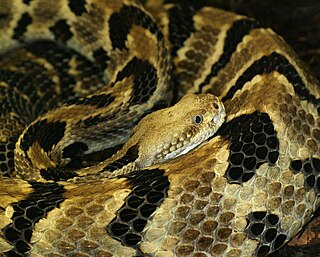
The Crotalinae, commonly known as pit vipers, crotaline snakes, or pit adders, are a subfamily of venomous vipers found in Eurasia and the Americas. They are distinguished by the presence of a heat-sensing pit organ located between the eye and the nostril on both sides of the head. Currently, 22 genera and 151 species are recognized: These are also the only viperids found in the Americas. The groups of snakes represented here include rattlesnakes, lanceheads, and Asian pit vipers. The type genus for this subfamily is Crotalus, of which the type species is the timber rattlesnake, C. horridus.
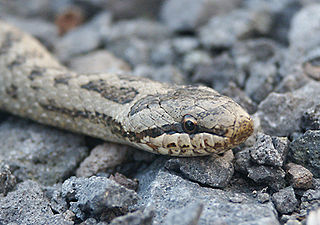
The smooth snake is a species of non-venomous snake in the family Colubridae. The species is found in northern and central Europe, but also as far east as northern Iran. The Reptile Database recognizes two subspecies as being valid, including the nominotypical subspecies described here.
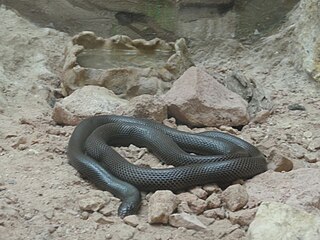
Atractaspis is a genus of venomous snakes in the family Lamprophiidae. The genus is endemic to Africa and the Middle East. The genus contains 15 species that are recognized by ITIS. Others recognize as many as 21 species. 23 are listed here.

Children's python is a species of nonvenomous snake in the family Pythonidae. The species is named after John George Children. It is a nocturnal species occurring in the northern half of Australia and generally found on the ground, although it often climbs trees. Usually growing to about 1.0 m (3 ft) in length, it is typically a reddish-brown colour, darker on the upper surface, and with many darker blotches, especially on younger specimens. It feeds mostly on small mammals and birds, and as with other pythons, it constricts its prey before swallowing it whole. It is a popular pet among reptile enthusiasts.

Bothriechis schlegelii, known commonly as the eyelash viper, is a species of venomous pit viper in the family Viperidae. The species is native to Central and South America. Small and arboreal, this species is characterized by a wide array of color variations, as well as the superciliary scales above the eyes. It is the most common of the green palm-pitvipers, and is often present in zoological exhibits. The specific name schlegelii honors Hermann Schlegel, who was a German ornithologist and herpetologist. For other common names see below. No subspecies are currently recognized as being valid.
Gloydius himalayanus is a venomous pitviper species found along the southern slopes of the Himalayas in Pakistan, India and Nepal. No subspecies are currently recognized.

Trimeresurus albolabris, the white-lipped pit viper, is a venomous pit viper species endemic to Southeast Asia.

Ahaetulla prasina is a species of snake in the family Colubridae native to southern Asia. Its common names include Asian vine snake, Boie's whip snake, Gunther's whip snake, Oriental whip snake.
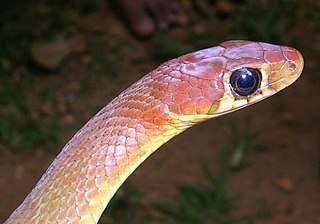
Hebius monticola is a harmless colubrid snake species endemic to the Western Ghats of India. They are especially well known from the Kodagu and Wayanad regions of the Western Ghats.

Boiga trigonata, commonly known as the Indian gamma snake or common cat snake, is a species of rear-fanged colubrid endemic to South Asia.

Coluber ventromaculatus, the glossy-bellied racer or Hardwicke's rat snake or Gray's rat snake, is a species of rat-snake or racer.
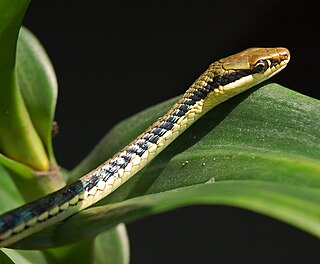
Dendrelaphis pictus is a species of snake found in Southeast Asia and India.

The White-banded wolf snake, also known as the Northern large-toothed snake, is a species of colubrid snake found in Asia.

Sibynophis collaris, commonly known as the common many-toothed snake,Betty's many toothed snake or the collared black-headed snake, is a species of colubrid snake endemic to South and East Asia.

Günther's black snake, Bothrolycus ater, is a species of poorly known lamprophiid snake endemic to central Africa. It is the only member of the genus, Bothrolycus. This snake is notable as one of the few snakes with notable sexual dimorphism, as well as possessing a small pit anterior to the eye. While superficially similar to the thermal pits of vipers, its function remains unknown.

Snakes, like other reptiles, have skin covered in scales. Snakes are entirely covered with scales or scutes of various shapes and sizes, known as snakeskin as a whole. A scale protects the body of the snake, aids it in locomotion, allows moisture to be retained within, alters the surface characteristics such as roughness to aid in camouflage, and in some cases even aids in prey capture. The simple or complex colouration patterns are a property of the underlying skin, but the folded nature of scaled skin allows bright skin to be concealed between scales then revealed in order to startle predators.
The Cameroon racer, Poecilopholis cameronensis, is a species of fangless venomous snake endemic to Africa. Poecilopholis is a monotypic genus created for this species.
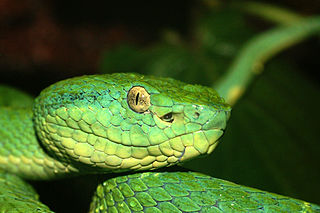
The loreal pit is the deep depression, or fossa, in the loreal area on either side of the head in pit vipers. It is located behind the nostril and in front of the eye, but below the line that runs between the centers of each. It is the external opening to an extremely sensitive infrared detecting organ. The loreal pit is bordered by lacunal scales. The loreal pit also functions as part of a thermal regulating system, enabling pit vipers to maintain their body temperature.

The common watersnake is a species of large, nonvenomous, common snake in the family Colubridae. The species is native to North America.
Lycodon cavernicolus, also known as Gua Wang Burma wolf snake, is a species of colubrid snake found in peninsular Malaysia. It was first described in 2014.